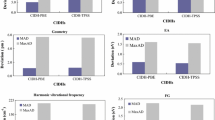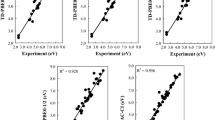Abstract
The performance of Hartree–Fock and twenty-three exchange–correlation functionals from Density Functional Theory was evaluated by means of experimental values of vertical excitation energies in metal complexes (tetraoxos, carbonyls, and halides) by using augmented basis sets of two different sizes, double- and triple-\(\zeta\). The analysis is carried out in terms of linear correlation parameters, that is, coefficients of determination and slope errors. In general, the results present only a small dependency with the basis set size. Range-separated hybrids (RSHs), mainly by LC-PBEPBE and LC-QTP, show the best performance for tetraoxo complexes. In addition, all methods provide poor results for carbonyls, where functionals from Local Density Approximation and Generalized Gradient Approximation (GGA) are better, followed by hybrids and RSHs. Moreover, hybrids, hybrid meta-GGAs (except for M06-HF), and mainly RSHs are more successful for halide complexes. Finally, considering all systems together, the functionals that provide the largest coefficients of determination (R2 \(\ge\) 0.98) along with the smallest slope errors (Error(\(\alpha\)) < 0.08) are the RSHs, except for CAM-QTP-00. This comparative investigation should contribute to future studies regarding the general analysis of optical properties in metal complexes.












Similar content being viewed by others
References
Jacquemin D, Wathelet V, Perpete EA, Adamo C (2009) Extensive TD-DFT benchmark: singlet-excited states of organic molecules. J Chem Theory Comput 5:2420–2435. https://doi.org/10.1021/ct900298e
Jacquemin D, Perpete EA, Scuseria GE, Ciofini I, Adamo C (2008) TD-DFT performance for the visible absorption spectra of organic dyes: conventional versus long-range hybrids. J Chem Theory Comput 4:123–135. https://doi.org/10.1021/ct700187z
Isegawa M, Peverati R, Truhlar DG (2012) Performance of recent and high-performance approximate density functionals for time-dependent density functional theory calculations of valence and Rydberg electronic transition energies. J Chem Phys 137:244104. https://doi.org/10.1063/1.4769078
Silva-Junior MR, Schreiber M, Sauer SP, Thiel W (2008) Benchmarks for electronically excited states: Time-dependent density functional theory and density functional theory based multireference configuration interaction. J Chem Phys 129:104103. https://doi.org/10.1063/1.2973541
Mendes RA, Haiduke RLA, Bartlett RJ (2021) The Devil’s Triangle of Kohn-Sham density functional theory and excited states. J Chem Phys 154:074106. https://doi.org/10.1063/5.0035446
Latouche C, Skouteris D, Palazzetti F, Barone V (2015) TD-DFT benchmark on inorganic Pt (II) and Ir (III) complexes. J Chem Theory Comput 11:3281–3289. https://doi.org/10.1021/acs.jctc.5b00257
Atkins AJ, Talotta F, Freitag L, Boggio-Pasqua M, González L (2017) Assessing excited state energy gaps with time-dependent density functional theory on Ru (II) complexes. J Chem Theory Comput 13:4123–4145. https://doi.org/10.1021/acs.jctc.7b00379
Adamo C, Jacquemin D (2013) The calculations of excited-state properties with Time-Dependent Density Functional Theory. Chem Soc Rev 42:845–856. https://doi.org/10.1039/C2CS35394F
Laurent AD, Jacquemin D (2013) TD-DFT benchmarks: a review. Int J Quantum Chem 113:2019–2039. https://doi.org/10.1002/qua.24438
Otero-de-la-Roza A, DiLabio GA (2020) Improved basis-set incompleteness potentials for accurate density-functional theory calculations in large systems. J Chem Theory Comput 16:4176–4191. https://doi.org/10.1021/acs.jctc.0c00102
Giner E, Scemama A, Toulouse J, Loos PF (2019) Chemically accurate excitation energies with small basis sets. J Chem Phys 151:144118. https://doi.org/10.1063/1.5122976
Rosa A, Baerends EJ, van Gisbergen SJ, van Lenthe E, Groeneveld JA, Snijders JG (1999) Electronic spectra of M (CO) 6 (M= Cr, Mo, W) revisited by a relativistic TDDFT approach. J Am Chem Soc 121:10356–10365. https://doi.org/10.1021/ja990747t
Cantero-López P, Páez-Hernández D, Arratia-Pérez R (2017) The origin of phosphorescence in Iridium (III) complexes. The role of relativistic effects. Chem Phys Lett 685:60–68. https://doi.org/10.1016/j.cplett.2017.07.006
Gaussian 09, Revision D.01, M.J. Frisch, G.W. Trucks, H.B. Schlegel, G.E. Scuseria, M.A. Robb, J.R. Cheeseman, G. Scalmani, V. Barone, G.A. Petersson, H. Nakatsuji, X. Li, M. Caricato, A. Marenich, J. Bloino, B.G. Janesko, R. Gomperts, B. Mennucci, H.P. Hratchian, J.V. Ortiz, A.F. Izmaylov, J.L. Sonnenberg, D. Williams-Young, F. Ding, F. Lipparini, F. Egidi, J. Goings, B. Peng, A. Petrone, T. Henderson, D. Ranasinghe, V.G. Zakrzewski, J. Gao, N. Rega, G. Zheng, W. Liang, M. Hada, M. Ehara, K. Toyota, R. Fukuda, J. Hasegawa, M. Ishida, T. Nakajima, Y. Honda, O. Kitao, H. Nakai, T. Vreven, K. Throssell, J.A. Montgomery, Jr., J.E. Peralta, F. Ogliaro, M. Bearpark, J.J. Heyd, E. Brothers, K.N. Kudin, V.N. Staroverov, T. Keith, R. Kobayashi, J. Normand, K. Raghavachari, A. Rendell, J.C. Burant, S.S. Iyengar, J. Tomasi, M. Cossi, J.M. Millam, M. Klene, C. Adamo, R. Cammi, J.W. Ochterski, R.L. Martin, K. Morokuma, O. Farkas, J.B. Foresman, D.J. Fox, Gaussian, Inc. Wallingford CT, 2009.
Perdew JP, Schmidt K (2001) Jacob’s ladder of density functional approximations for the exchange-correlation energy. AIP Conf Proc 577:1–20. https://doi.org/10.1063/1.1390175
Dunning TH (1989) Gaussian basis sets for use in correlated molecular calculations. I. The atoms boron through neon and hydrogen. J Chem Phys 90:1007–1023. https://doi.org/10.1063/1.456153
Kendall RA, Dunning TH, Harrison RJ (1992) Electron affinities of the first-row atoms revisited. Systematic basis sets and wave functions. J Chem Phys 96:6796–6806. https://doi.org/10.1063/1.462569
Woon DE, Dunning TH (1993) Gaussian basis sets for use in correlated molecular calculations. III. The atoms aluminum through argon. J Chem Phys 98:1358–1371. https://doi.org/10.1063/1.464303
Figgen D, Peterson KA, Dolg M, Stoll H (2009) Energy-consistent pseudopotentials and correlation consistent basis sets for the 5d elements Hf-Pt. J Chem Phys 130:164108. https://doi.org/10.1063/1.3119665
Metz B, Stoll H, Dolg M (2000) Small-core multiconfiguration-Dirac-Hartree-Fock-adjusted pseudopotentials for post-d main group elements: Application to PbH and PbO. J Chem Phys 113:2563–2569. https://doi.org/10.1063/1.1305880
Peterson KA (2003) Systematically convergent basis sets with relativistic pseudopotentials. I. Correlation consistent basis sets for the post-d group 13–15 elements. J Chem Phys 119:11099–11112. https://doi.org/10.1063/1.1622923
Peterson KA, Figgen D, Dolg M, Stoll H (2007) Energy-consistent relativistic pseudopotentials and correlation consistent basis sets for the 4d elements Y-Pd. J Chem Phys 126:124101. https://doi.org/10.1063/1.2647019
Barrett GB (2000) The Coefficient of Determination: Understanding r squared and R squared. Math Teach 93:230–234. https://doi.org/10.5951/MT.93.3.0230
Hartree DR (1928) The wave mechanics of an atom with a non-Coulomb central field. Part I. Theory and methods. Proc Cambridge Phil Soc 24:89. https://doi.org/10.1017/S0305004100011919
Fock V (1930) Näherungsmethode zur Lösung des quantenmechanischen Mehrkörperproblems. Z Phys 61:126–148
Slater JC (1930) Note on Hartree’s method. Phy Rev 35:210. https://doi.org/10.1103/PhysRev.35.210.2
Slater JC, Johnson KH (1972) Self-consistent-field X α cluster method for polyatomic molecules and solids. Phys Rev B 5:844. https://doi.org/10.1103/PhysRevB.5.844
Vosko SH, Wilk L, Nusair M (1980) Accurate spin-dependent electron liquid correlation energies for local spin density calculations: a critical analysis. Can J Phys 58:1200–1211. https://doi.org/10.1139/p80-159
Becke AD (1988) Density-functional exchange-energy approximation with correct asymptotic behavior. Phys Rev A 38:3098. https://doi.org/10.1103/PhysRevA.38.3098
Lee C, Yang W, Parr RG (1988) Development of the Colle-Salvetti correlation-energy formula into a functional of the electron density. Phys Rev B 37:785. https://doi.org/10.1103/PhysRevB.37.785
Perdew JP (1986) Density-functional approximation for the correlation energy of the inhomogeneous electron gas. Phys Rev B 33:8822. https://doi.org/10.1103/PhysRevB.33.8822
Perdew JP, Burke K, Ernzerhof M (1996) Generalized gradient approximation made simple. Phys Rev Lett 77:3865. https://doi.org/10.1103/PhysRevLett.77.3865
Zhao Y, Truhlar DG (2006) A new local density functional for main-group thermochemistry, transition metal bonding, thermochemical kinetics, and noncovalent interactions. J Chem Phys 125:194101. https://doi.org/10.1063/1.2370993
Tao J, Perdew JP, Staroverov VN, Scuseria GE (2003) Climbing the density functional ladder: nonempirical meta–generalized gradient approximation designed for molecules and solids. Phy Rev Lett 91:146401. https://doi.org/10.1103/PhysRevLett.91.146401
Boese AD, Handy NC (2002) New exchange-correlation density functionals: the role of the kinetic-energy density. J Chem Phys 116:9559–9569. https://doi.org/10.1063/1.1476309
Becke AD (1993) Density-functional thermochemistry. III. The role of exact exchange. J Chem Phys 98:5648. https://doi.org/10.1063/1.464913
Stephens PJ, Devlin FJ, Chabalowski CF, Frisch MJ (1994) Ab initio calculation of vibrational absorption and circular dichroism spectra using density functional force fields. J Phys Chem 98:11623–11627. https://doi.org/10.1021/j100096a001
Adamo C, Barone V (1998) Exchange functionals with improved long-range behavior and adiabatic connection methods without adjustable parameters: The mPW and mPW1PW models. J Chem Phys 108:664. https://doi.org/10.1063/1.475428
Ernzerhof M, Scuseria GE (1999) Assessment of the Perdew–Burke–Ernzerhof exchange-correlation functional. J Chem Phys 110:5029–5036. https://doi.org/10.1063/1.478401
Adamo C, Barone V (1999) Toward reliable density functional methods without adjustable parameters: the PBE0 model. J Chem Phys 110:6158–6170. https://doi.org/10.1063/1.478522
Boese AD, Martin JM (2004) Development of density functionals for thermochemical kinetics. J Chem Phys 121:3405–3416. https://doi.org/10.1063/1.1774975
Zhao Y, Truhlar DG (2006) Density functional for spectroscopy: no long-range self-interaction error, good performance for Rydberg and charge-transfer states, and better performance on average than B3LYP for ground states. J Phys Chem A 110:13126–13130. https://doi.org/10.1021/jp066479k
Zhao Y, Truhlar D, G, (2008) The M06 suite of density functionals for main group thermochemistry, thermochemical kinetics, noncovalent interactions, excited states, and transition elements: two new functionals and systematic testing of four M06-class functionals and 12 other functionals. Theor Chem Acc 120:215–241. https://doi.org/10.1007/s00214-007-0401-8
Yanai T, Tew DP, Handy NC (2004) A new hybrid exchange–correlation functional using the Coulomb-attenuating method (CAM-B3LYP). Chem Phys Lett 393:51–57. https://doi.org/10.1016/j.cplett.2004.06.011
Iikura H, Tsuneda T, Yanai T, Hirao K (2001) A long-range correction scheme for generalized-gradient-approximation exchange functionals. J Chem Phys 115:3540–3544. https://doi.org/10.1063/1.1383587
Vydrov OA, Scuseria GE (2006) Assessment of a long-range corrected hybrid functional. J Chem Phys 125:234109. https://doi.org/10.1063/1.2409292
Vydrov OA, Heyd J, Krukau AV, Scuseria GE (2006) Importance of short-range versus long-range Hartree–Fock exchange for the performance of hybrid density functionals. J Chem Phys 125:074106. https://doi.org/10.1063/1.2244560
Chai JD, Head-Gordon M (2008) Systematic optimization of long-range corrected hybrid density functionals. J Chem Phys 128:084106. https://doi.org/10.1063/1.2834918
Chai JD, Head-Gordon M (2008) Long-range corrected hybrid density functionals with damped atom–atom dispersion corrections. Phys Chem Chem Phys 10:6615–6620. https://doi.org/10.1039/B810189B
Verma P, Bartlett RJ (2014) Increasing the applicability of density functional theory. IV. Consequences of ionization-potential improved exchange-correlation potentials. J Chem Phys 140:18A534. https://doi.org/10.1063/1.4871409
Jin Y, Bartlett RJ (2016) The QTP family of consistent functionals and potentials in Kohn-Sham density functional theory. J Chem Phys 145:034107. https://doi.org/10.1063/1.4955497
Haiduke RLA, Bartlett RJ (2018) Non-empirical exchange-correlation parameterizations based on exact conditions from correlated orbital theory. J Chem Phys 148:184106. https://doi.org/10.1063/1.5025723
Stückl A, Daul C, Güdel H (1997) Excited-state energies and distortions of d0 transition metal tetraoxo complexes: A density functional study. J Chem Phy 107:4606–4617. https://doi.org/10.1063/1.474821
Pierloot K, Tsokos E, Vanquickenborne LG (1996) Optical spectra of Ni (CO)4 and Cr (CO)6 revisited. J Phys Chem 100:16545–16550. https://doi.org/10.1021/jp9614355
Rosa A, Baerends EJ, van Gisbergen SJ, van Lenthe E, Groeneveld JA, Snijders JG (1999) Electronic spectra of M(CO)6 (M= Cr, Mo, W) revisited by a relativistic TDDFT approach. J Am Chem Soc 121:10356–10365. https://doi.org/10.1021/ja990747t
Nakai H, Morita H, Tomasello P, Nakatsuji H (1998) Electronic structures of MoF6 and MoOF4 in the ground and excited states: A SAC-CI and frozen-orbital-analysis study. J Phys Chem A 102:2033–2043. https://doi.org/10.1021/jp973052s
Adamo C, Barone V (2000) Inexpensive and accurate predictions of optical excitations in transition-metal complexes: the TDDFT/PBE0 route. Theor Chem Acc 105:169–172. https://doi.org/10.1007/s002140000202
Nakatsuji H, Ehara M, Palmer MH, Guest MF (1992) Theoretical study on the excited and ionized states of titanium tetrachloride. J Chem Phys 97:2561–2570. https://doi.org/10.1063/1.463095
Fujii H, Kimura M (1970) The molecular structure of tin tetrachloride as determined by gas-electron diffraction. Bull Chem Soc Jpn 43:1933–1939. https://doi.org/10.1246/bcsj.43.1933
Ziegler T, Rauk A, Baerends EJ (1976) The electronic structures of tetrahedral oxo-complexes. The nature of the “charge transfer” transitions. Chem Phys 16:209–217. https://doi.org/10.1016/0301-0104(76)80056-0
Amor NB, Villaume S, Maynau D, Daniel C (2006) The electronic spectroscopy of transition metal carbonyls: The tough case of Cr (CO)6. Chem Phys Lett 421:378–382. https://doi.org/10.1016/j.cplett.2006.02.002
Petit L, Maldivi P, Adamo C (2005) Predictions of optical excitations in transition-metal complexes with time dependent-density functional theory: influence of basis sets. J Chem Theory Comput 1:953–962. https://doi.org/10.1021/ct0500500
Iverson AA, Russell BR (1973) Electronic spectra of TiCl4, VCl4 and SnCl4 in the vacuum ultraviolet. Spectrochim Acta A 29:715. https://doi.org/10.1016/0584-8539(73)80101-1
Acknowledgements
RLAH is grateful to The São Paulo Research Foundation (FAPESP) for financial support (2014/23714-1) and to National Council for Scientific and Technological Development (CNPq) for a research grant (301211/2018-3). RAM thanks the Center for Mathematical Sciences Applied to Industry (CeMEAI) – FAPESP 2013/07375-0 for computational resources. This research was supported in part by the Coordenação de Aperfeiçoamento de Pessoal de Nível Superior Brasil (CAPES)—Finance Code 001.
Author information
Authors and Affiliations
Corresponding author
Ethics declarations
Conflict of interest
The authors report no declarations of interest.
Additional information
Publisher's Note
Springer Nature remains neutral with regard to jurisdictional claims in published maps and institutional affiliations.
Supplementary Information
Below is the link to the electronic supplementary material.
Rights and permissions
About this article
Cite this article
Mendes, R.A., Haiduke, R.L.A. Performance of new exchange–correlation functionals in providing vertical excitation energies of metal complexes. Theor Chem Acc 140, 146 (2021). https://doi.org/10.1007/s00214-021-02844-8
Received:
Accepted:
Published:
DOI: https://doi.org/10.1007/s00214-021-02844-8




